La belle au bois dormant / Sleeping Beauty
vendredi 11 avril 2014
As my blog layout is currently Sleeping beauty-themed I though I'd start my fairytales-related entries with that one. You probably know Disney's take on Sleeping Beauty but it's a seriously toned-down and "soft" version of this famous fairytale.
 Origins and alternative versions of the tale
Origins and alternative versions of the tale
There are many similarities between a French 14th century tale called
Perceforest. It's also believed that
Il Pentamerone (1636) contained an early version of "Sleeping Beauty" which strongly influenced
Charles Perrault's famous tales. The Grimm brothers published another version of Sleeping Beauty:
Briar Rose which is VERY tame and which I belived is the version used for Disney's movie and the one most people heard of: at the end of the tale, the Prince kisses the sleeping princess awake (and they live happily ever after)...
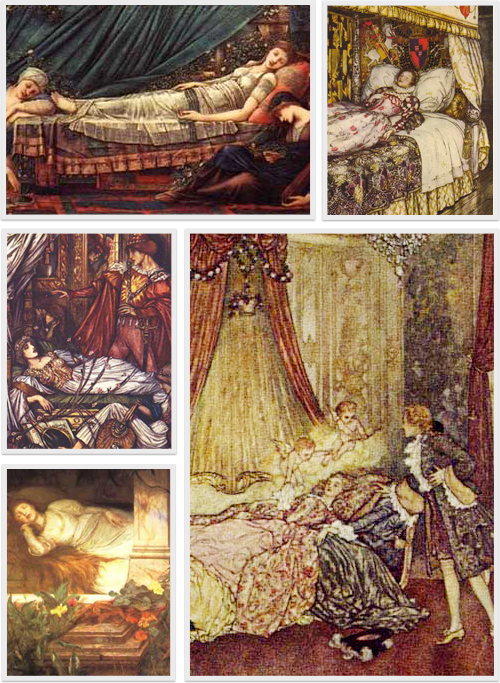
Illustrations by Edmond Dulac, Arthur Rackham, Edward Frederick Brewtnall, Edward Burne-Jones, Herbert Cole
 Perrault's version of Sleeping Beauty
Perrault's version of Sleeping Beauty
First of all, Perrault did not write for children, like La Fontaine's well-knowed
Fables they were just a way to avoid censorship and to send messages to the nobility living at king Louis XIV's court. Hence Perrault's tale does not stop when the sleeping princess wakes-up.
After the princess wakes-up, she marries the prince and they have several children. But the prince's mother actually is an ogre and while the prince is away she asks her cook to kill every one of her grand children and cook them for dinner. The cook who does not have the courage to kill the innocent children, instead hide them and gives fawns to the ogre. But she's still not satisfied and asks the cook to kill her daughter-in-law and cook her for dinner. The cook who's a good man decides not to kill the princess and hides her and gives the old queen some deer for dinner.
But some day, as the princess and her children are playing, hidden in the cook's house, the old queen hears them and have them brought. She then decides not to eat them but to throw them in a pit filled with snakes. But as she intends to do so, the prince comes back from war or whatever he was away for... And in rage and fear of punishment, the old queen jumps in the pit and dies. THE END. This version is pretty dark as cannibalism is a theme which has been often forgotten in most children's books.
 Alternative version of Sleeping Beauty (NSFW)
Alternative version of Sleeping Beauty (NSFW)
In other older and alternative versions of the tale, as in
Perceforest, the prince discovers the sleeping princess while hunting in the woods. He falls in love with her and then instead of trying to wake her up, he just rapes her. Yes, he rapes her in her sleep and he comes back several time, not telling anyone what/who lied in the midst of the woods. The princess soon gets pregnant and gives brith, still not waking-up. But her child getting hungry grabs one of her mother's finger and starts sucking on it hence removing the pin which had condemned her to eternal slumber. The princess then woke-up and the prince who had come to the woods again discovers the princess awake with their child and decides to marry her (how convenient)!
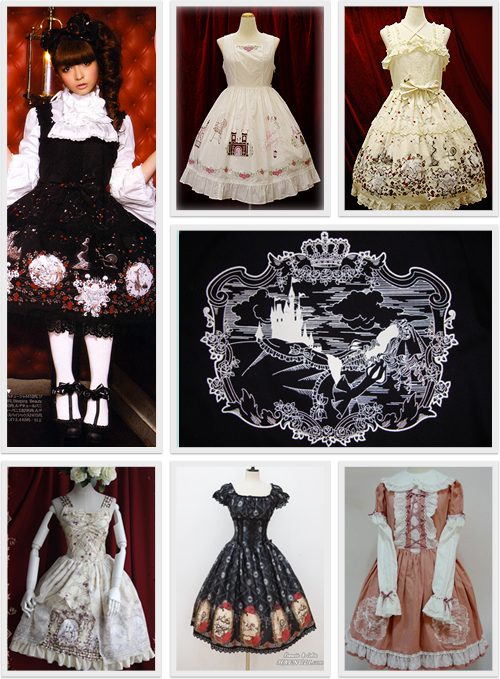
Sleeping Beauty used in lolita: Bssb, Angelic Pretty, Hanuli and Infanta
 Sleeping Beauty in other media
Sleeping Beauty in other media
As seen above,
Sleeping beauty has been used in lolita several times by differnt brands and is a reccurent theme as many other fairytales (Juliette et Justine also made a
Rpbe de la belle au bois dormant).
You might also have heard of the ballet based on
Sleeping Beauty. The music was composed by
Tchaikovsky and the choregraphy created by
Marius Petipa. Disney's movie uses some of Tchaikovsky's music in their animated movie. The ballet is pretty famous and the part of Princess Aurora is quite a challenge for dancers, especially its
Rose adagio which is one of the most difficult variation.
Edward Burne-Jones made a several paintings based on
Sleeping beauty: "
The legend of Briar Rose". Each panel comes with a poem written by
William Morris.
Sleeping beauty is also sometimes used as a motif in fashion editorials even if it's not the most used fairytale in fashion (see below).
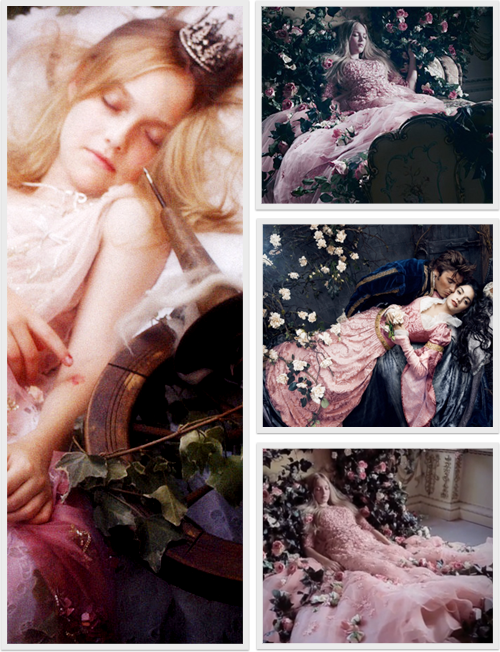
Credits: Dakota Fanning by Karl Lagerfeld, Ad for Harrods by Patrick Naik, Annie Leibovitz for Disney
Libellés : art and litterature, fairytales, fashion, lolita, music and ballet
La belle au bois dormant / Sleeping Beauty
As my blog layout is currently Sleeping beauty-themed I though I'd start my fairytales-related entries with that one. You probably know Disney's take on Sleeping Beauty but it's a seriously toned-down and "soft" version of this famous fairytale.
 Origins and alternative versions of the tale
Origins and alternative versions of the tale
There are many similarities between a French 14th century tale called
Perceforest. It's also believed that
Il Pentamerone (1636) contained an early version of "Sleeping Beauty" which strongly influenced
Charles Perrault's famous tales. The Grimm brothers published another version of Sleeping Beauty:
Briar Rose which is VERY tame and which I belived is the version used for Disney's movie and the one most people heard of: at the end of the tale, the Prince kisses the sleeping princess awake (and they live happily ever after)...

Illustrations by Edmond Dulac, Arthur Rackham, Edward Frederick Brewtnall, Edward Burne-Jones, Herbert Cole
 Perrault's version of Sleeping Beauty
Perrault's version of Sleeping Beauty
First of all, Perrault did not write for children, like La Fontaine's well-knowed
Fables they were just a way to avoid censorship and to send messages to the nobility living at king Louis XIV's court. Hence Perrault's tale does not stop when the sleeping princess wakes-up.
After the princess wakes-up, she marries the prince and they have several children. But the prince's mother actually is an ogre and while the prince is away she asks her cook to kill every one of her grand children and cook them for dinner. The cook who does not have the courage to kill the innocent children, instead hide them and gives fawns to the ogre. But she's still not satisfied and asks the cook to kill her daughter-in-law and cook her for dinner. The cook who's a good man decides not to kill the princess and hides her and gives the old queen some deer for dinner.
But some day, as the princess and her children are playing, hidden in the cook's house, the old queen hears them and have them brought. She then decides not to eat them but to throw them in a pit filled with snakes. But as she intends to do so, the prince comes back from war or whatever he was away for... And in rage and fear of punishment, the old queen jumps in the pit and dies. THE END. This version is pretty dark as cannibalism is a theme which has been often forgotten in most children's books.
 Alternative version of Sleeping Beauty (NSFW)
Alternative version of Sleeping Beauty (NSFW)
In other older and alternative versions of the tale, as in
Perceforest, the prince discovers the sleeping princess while hunting in the woods. He falls in love with her and then instead of trying to wake her up, he just rapes her. Yes, he rapes her in her sleep and he comes back several time, not telling anyone what/who lied in the midst of the woods. The princess soon gets pregnant and gives brith, still not waking-up. But her child getting hungry grabs one of her mother's finger and starts sucking on it hence removing the pin which had condemned her to eternal slumber. The princess then woke-up and the prince who had come to the woods again discovers the princess awake with their child and decides to marry her (how convenient)!

Sleeping Beauty used in lolita: Bssb, Angelic Pretty, Hanuli and Infanta
 Sleeping Beauty in other media
Sleeping Beauty in other media
As seen above,
Sleeping beauty has been used in lolita several times by differnt brands and is a reccurent theme as many other fairytales (Juliette et Justine also made a
Rpbe de la belle au bois dormant).
You might also have heard of the ballet based on
Sleeping Beauty. The music was composed by
Tchaikovsky and the choregraphy created by
Marius Petipa. Disney's movie uses some of Tchaikovsky's music in their animated movie. The ballet is pretty famous and the part of Princess Aurora is quite a challenge for dancers, especially its
Rose adagio which is one of the most difficult variation.
Edward Burne-Jones made a several paintings based on
Sleeping beauty: "
The legend of Briar Rose". Each panel comes with a poem written by
William Morris.
Sleeping beauty is also sometimes used as a motif in fashion editorials even if it's not the most used fairytale in fashion (see below).

Credits: Dakota Fanning by Karl Lagerfeld, Ad for Harrods by Patrick Naik, Annie Leibovitz for Disney
Libellés : art and litterature, fairytales, fashion, lolita, music and ballet
The legend of Briar Rose
"The fateful slumber floats and flows
About the tangle of the rose."
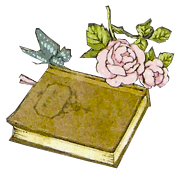
 평화 [pʰjəŋ.hwa]
평화 [pʰjəŋ.hwa]
Child of the 80's born in Seoul (South Korea) - Living and working in Paris (France) - Languages spoken: French / English (surprise surprise, despite my place of birth I don't speak or understand a word of Korean!) - Languages studied but not practiced enough to speak them fluently: Spanish / Japanese / Latin (not spoken anymore anyway) / Ancient Greek - Studied: History / specialised in French Medival History -
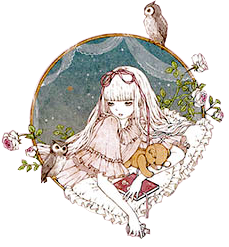




















 평화 [pʰjəŋ.hwa]
평화 [pʰjəŋ.hwa]
Enregistrer un commentaire
1. Comments are moderated.
2. Please don't post spam/advertisements, or your comment won't be published.
3. At last, thanks for your comment!